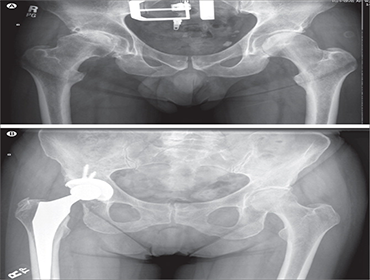Total Hip Arthroplasty
Home / Total Hip Arthroplasty
Total Hip Arthroplasty
Get AppointmentWhat is Total hip arthroplasty?
Total hip arthroplasty (THA), also known as a total hip replacement (THR), is an orthopaedic procedure that involves the surgical excision of the femoral head and cartilage of the acetabulum and replacement of the joint with articulating femoral and acetabular components. It is a commonly performed procedure usually with very good results and a return to function.
Common Causes of Hip Pain
The most common cause of severe hip pain and disability is arthritis. Several types of arthritis affect the hip joint. Some of these include Osteoarthritis, rheumatoid arthritis, and traumatic arthritis.
Osteoarthritis: This is a “wear and tear” type of arthritis and is often age-related. It more commonly occurs in people who are more than 50 years of age and older and in people with a history of arthritis running in the family. The cartilage support of the bones of the hip wears away. The bones then start rubbing against each other, and it leads to severe hip pain and stiffness. Osteoarthritis is also caused or aggravated by irregularities in how the hip developed during childhood.
Rheumatoid Arthritis: This is an autoimmune disease in which the synovial membrane becomes inflamed and thickened. This chronic inflammation can damage the cartilage, leading to pain and stiffness. Rheumatoid arthritis is the most common type of a group of disorders termed “inflammatory arthritis.”
Post-traumatic Arthritis: This often follows a critical hip injury or fracture. The cartilage becomes damaged and leads to hip pain and stiffness over time.
Avascular Necrosis: Hip injuries, such as a dislocation or fracture, impairs the blood supply to the femoral head. This is called avascular necrosis (also popularly referred to as “osteonecrosis”). The lack of blood causes the surface of the bone to crumple and results in arthritis. Some diseases can also cause avascular necrosis.
Childhood Hip Disease: Some infants and children develop hip problems. Even though the issues are effectively treated during childhood, they may still sometimes cause arthritis later on in life. This happens because the hip fails to grow normally, and the joint surfaces get affected.
In hip osteoarthritis, the smooth articular cartilage wears away and becomes frayed and rough.
In a total hip replacement (also known as total hip arthroplasty), the worn-out bone and cartilage are removed and replaced with prosthetic components.
What symptoms may indicate that I need a hip replacement?
Some of the following symptoms may be related to conditions that hip replacements address. They include:
- Pain in the anterior hip or groin.
- Pain in the buttock and trochanteric region.
- Pain with activity and at rest.
- Pain that gets worse when you put weight on the leg.
- Stiffness/tightness of the hip.
- Loss of motion.
- Difficulty sleeping.
- Difficulty walking.
- Difficulty putting on shoes and socks.
Hip Replacement Surgery
The worn-out femoral head is done away with and is replaced with a metal stem which is put into the hollow centre of the femur. The femoral stem is then either fixed or “press-fit” into the bone.
A metal or ceramic ball is kept on the stem’s upper part. This ball replaces the worn-out femoral head that was removed.
The worn-out cartilage surface of the socket (acetabulum) is removed and replaced with a metal socket. Many times, screws or cement are taken help of to hold the socket in place.
A metal, plastic or ceramic spacer is put in between the new ball and the socket to enable a smooth gliding surface.
The incision is sealed with stitches or surgical staples.

Post-Surgery Recovery & Care
The time taken for total hip replacement surgery is about one and a half hours. Most patients also often stay in the hospital for one or two days after the procedure. Once the patient is home, it is vital to keep the area of the surgery clean and dry. It is also essential to religiously follow all the instructions of the doctor provided at the time of discharge.
Your rehabilitation will begin within 24 hours after surgery. Most hip replacement patients progress to walking with a cane, walker, or crutches within a day or two after surgery. As the days progress, you will increase the distance and frequency of walking. Full recovery generally takes anywhere from two to eight weeks, depending on the patient’s general health and other factors.
GET APPOINTMENT
Schedule Appointment : Your Path to Specialized Care
Get rid of your pain, stress, and enduring with our 24/7 dental services. It's a priority to relieve the pain in surgeon as much as possible. 90% of customers claim that they would come back & recommend us to others.
